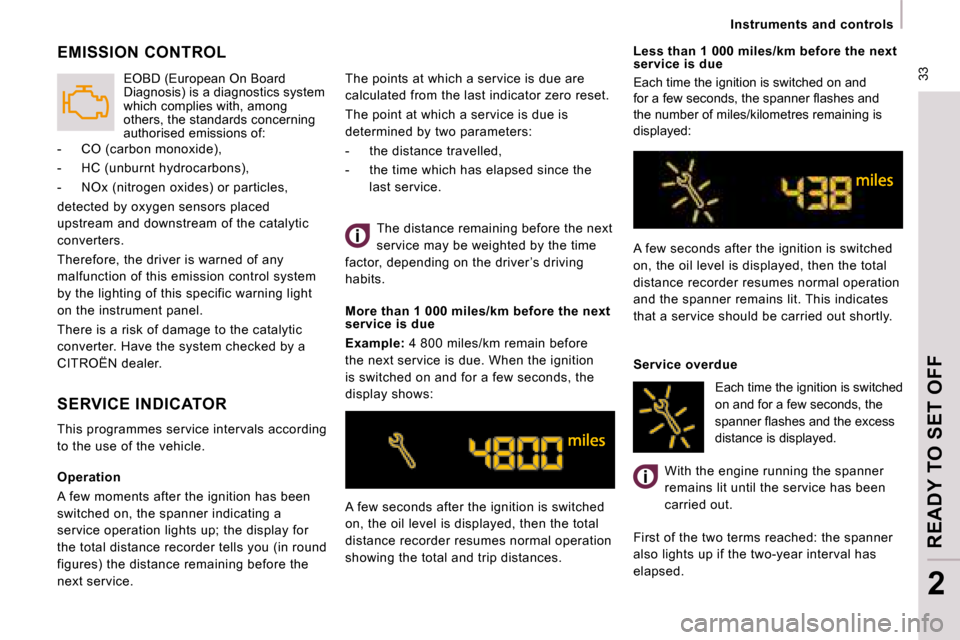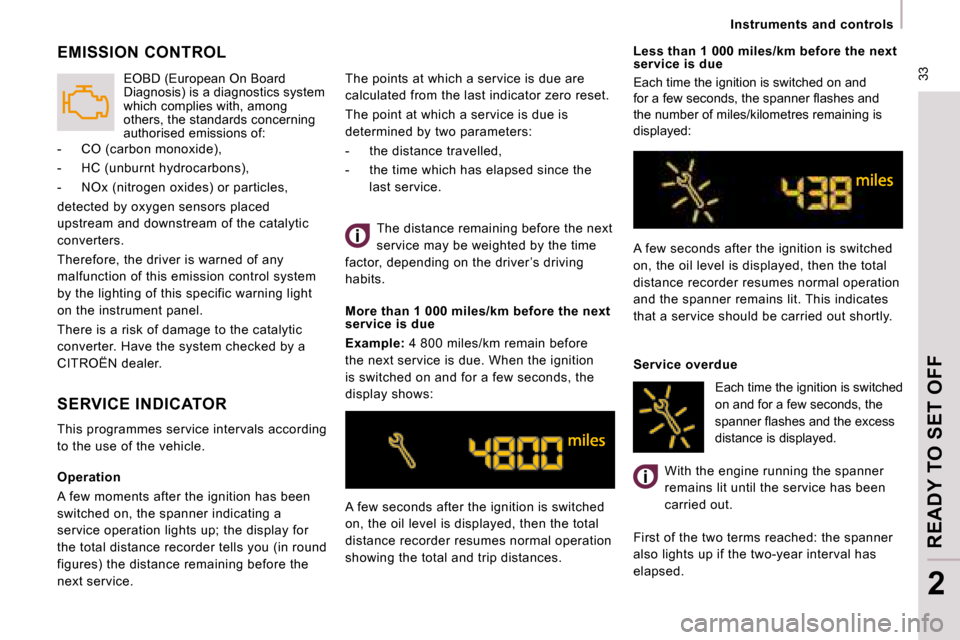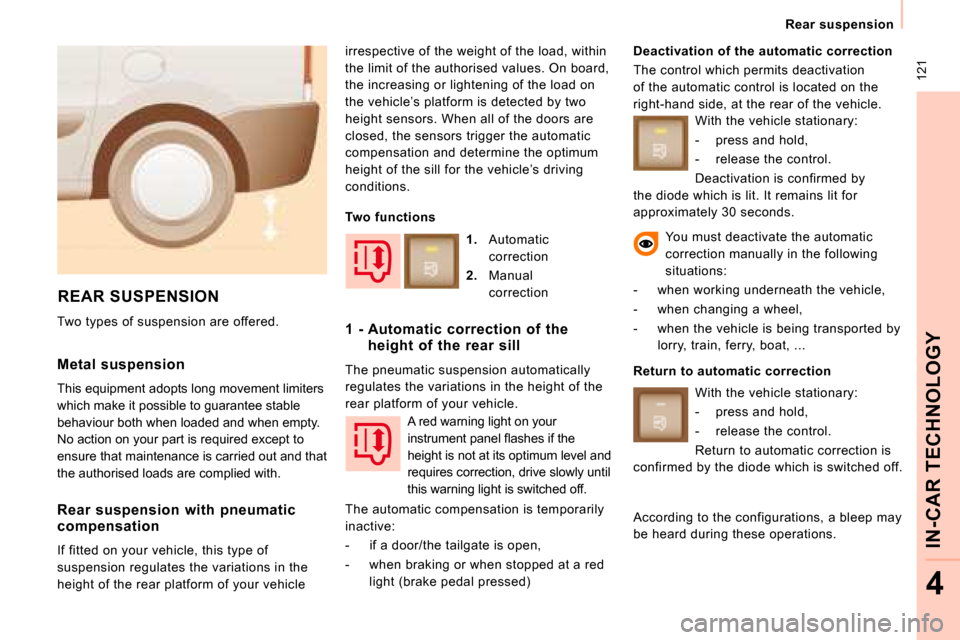weight Citroen JUMPY 2008.5 2.G Owner's Manual
[x] Cancel search | Manufacturer: CITROEN, Model Year: 2008.5, Model line: JUMPY, Model: Citroen JUMPY 2008.5 2.GPages: 185, PDF Size: 6.66 MB
Page 33 of 185

33
Instruments and controls
READY TO SET OFF
2
Operation
A few moments after the ignition has been
switched on, the spanner indicating a
service operation lights up; the display for
the total distance recorder tells you (in round
figures) the distance remaining before the
next service. A few seconds after the ignition is switched
on, the oil level is displayed, then the total
distance recorder resumes normal operation
showing the total and trip distances. Less than 1 000 miles/km before the next
service is due
Each time the ignition is switched on and
�f�o�r� �a� �f�e�w� �s�e�c�o�n�d�s�,� �t�h�e� �s�p�a�n�n�e�r� �fl� �a�s�h�e�s� �a�n�d�
the number of miles/kilometres remaining is
displayed:
A few seconds after the ignition is switched
on, the oil level is displayed, then the total
distance recorder resumes normal operation
and the spanner remains lit. This indicates
that a service should be carried out shortly.
Service overdue
With the engine running the spanner
remains lit until the service has been
carried out.
First of the two terms reached: the spanner
also lights up if the two-year interval has
elapsed.
The distance remaining before the next
service may be weighted by the time
factor, depending on the driver ’s driving
habits.
More than 1 000 miles/km before the next
service is due
Example: 4 800 miles/km remain before
the next service is due. When the ignition
is switched on and for a few seconds, the
display shows:
SERVICE INDICATOR
This programmes service intervals according
to the use of the vehicle.
EMISSION CONTROL
- CO (carbon monoxide),
- HC (unburnt hydrocarbons),
- NOx (nitrogen oxides) or particles,
detected by oxygen sensors placed
upstream and downstream of the catalytic
converters.
Therefore, the driver is warned of any
malfunction of this emission control system
by the lighting of this specific warning light
on the instrument panel.
There is a risk of damage to the catalytic
converter. Have the system checked by a
CITROËN dealer. EOBD (European On Board
Diagnosis) is a diagnostics system
which complies with, among
others, the standards concerning
authorised emissions of:
Each time the ignition is switched
on and for a few seconds, the
�s�p�a�n�n�e�r� �fl� �a�s�h�e�s� �a�n�d� �t�h�e� �e�x�c�e�s�s�
distance is displayed.
The points at which a service is due are
calculated from the last indicator zero reset.
The point at which a service is due is
determined by two parameters:
- the distance travelled,
- the time which has elapsed since the
last service.
Page 34 of 185

33
Instruments and controls
READY TO SET OFF
2
Operation
A few moments after the ignition has been
switched on, the spanner indicating a
service operation lights up; the display for
the total distance recorder tells you (in round
figures) the distance remaining before the
next service. A few seconds after the ignition is switched
on, the oil level is displayed, then the total
distance recorder resumes normal operation
showing the total and trip distances. Less than 1 000 miles/km before the next
service is due
Each time the ignition is switched on and
�f�o�r� �a� �f�e�w� �s�e�c�o�n�d�s�,� �t�h�e� �s�p�a�n�n�e�r� �fl� �a�s�h�e�s� �a�n�d�
the number of miles/kilometres remaining is
displayed:
A few seconds after the ignition is switched
on, the oil level is displayed, then the total
distance recorder resumes normal operation
and the spanner remains lit. This indicates
that a service should be carried out shortly.
Service overdue
With the engine running the spanner
remains lit until the service has been
carried out.
First of the two terms reached: the spanner
also lights up if the two-year interval has
elapsed.
The distance remaining before the next
service may be weighted by the time
factor, depending on the driver ’s driving
habits.
More than 1 000 miles/km before the next
service is due
Example: 4 800 miles/km remain before
the next service is due. When the ignition
is switched on and for a few seconds, the
display shows:
SERVICE INDICATOR
This programmes service intervals according
to the use of the vehicle.
EMISSION CONTROL
- CO (carbon monoxide),
- HC (unburnt hydrocarbons),
- NOx (nitrogen oxides) or particles,
detected by oxygen sensors placed
upstream and downstream of the catalytic
converters.
Therefore, the driver is warned of any
malfunction of this emission control system
by the lighting of this specific warning light
on the instrument panel.
There is a risk of damage to the catalytic
converter. Have the system checked by a
CITROËN dealer. EOBD (European On Board
Diagnosis) is a diagnostics system
which complies with, among
others, the standards concerning
authorised emissions of:
Each time the ignition is switched
on and for a few seconds, the
�s�p�a�n�n�e�r� �fl� �a�s�h�e�s� �a�n�d� �t�h�e� �e�x�c�e�s�s�
distance is displayed.
The points at which a service is due are
calculated from the last indicator zero reset.
The point at which a service is due is
determined by two parameters:
- the distance travelled,
- the time which has elapsed since the
last service.
Page 60 of 185

59
Seats
ERGONOMICS and COMFORT
3
FRONT SEATS
Depending on the version and configuration
of your vehicle, different front seats are
fitted, either:
- a driver ’s seat and a passenger seat,
- an individual driver ’s seat and a two-seat passenger bench.
Depending on the models, the following
adjustments are available: 3 - Driver ’s seat height adjustment
Depending on the version and configuration
of your vehicle, you have either:
- a passive adjustment: pull the handle
upwards then take your weight off the
seat to raise, or push on the seat to
lower,
2 - Seat back angle adjustment
Pull the lever upwards and set the required
angle.
1 - Forwards/backwards adjustment
Lift the bar and slide the seat forwards or
backwards.
Page 121 of 185

121
Rear suspension
IN-CAR TECHNOLOGY
4
Metal suspension
This equipment adopts long movement limiters
which make it possible to guarantee stable
behaviour both when loaded and when empty.
No action on your part is required except to
ensure that maintenance is carried out and that
the authorised loads are complied with. irrespective of the weight of the load, within
the limit of the authorised values. On board,
the increasing or lightening of the load on
the vehicle’s platform is detected by two
height sensors. When all of the doors are
closed, the sensors trigger the automatic
compensation and determine the optimum
height of the sill for the vehicle’s driving
conditions.
Deactivation of the automatic correction
The control which permits deactivation
of the automatic control is located on the
right-hand side, at the rear of the vehicle.
REAR SUSPENSION
You must deactivate the automatic
correction manually in the following
situations:
- when working underneath the vehicle,
- when changing a wheel,
- when the vehicle is being transported by lorry, train, ferry, boat, ...
Two types of suspension are offered.
Rear suspension with pneumatic
compensation
If fitted on your vehicle, this type of
suspension regulates the variations in the
height of the rear platform of your vehicle
1. Automatic
correction
2. Manual
correction
1 - Automatic correction of the height of the rear sill
The pneumatic suspension automatically
regulates the variations in the height of the
rear platform of your vehicle. A red warning light on your
�i�n�s�t�r�u�m�e�n�t� �p�a�n�e�l� �fl� �a�s�h�e�s� �i�f� �t�h�e�
height is not at its optimum level and
requires correction, drive slowly until
this warning light is switched off.
The automatic compensation is temporarily
inactive:
- if a door/the tailgate is open,
- when braking or when stopped at a red light (brake pedal pressed) With the vehicle stationary:
- press and hold,
- release the control.
Deactivation is confirmed by
the diode which is lit. It remains lit for
approximately 30 seconds.
Return to automatic correction
With the vehicle stationary:
- press and hold,
- release the control.
Return to automatic correction is
confirmed by the diode which is switched off.
According to the configurations, a bleep may
be heard during these operations.
Two functions
Page 136 of 185

135
Child safety
SAFETY
5
GENERAL POINTS RELATING TO CHILD SEATS
Although one of CITROËN main criteria
when designing your vehicle, the safety of
your children also depends on you.
For maximum safety, please follow these
precautions:
- all children under the age of 12 or less than one metre fifty tall must travel in
approved child seats suited to their
weight, on seats fitted with a seat belt or
ISOFIX mountings.
- statistically, the safest seats in your vehicle for the transportation of children
are the rear seats,
- a child weighing less than 9 kg must travel in the "rearwards-facing" position
both in the front and in the rear. "Rearwards-facing"
When a "rearwards-facing" child seat is
installed on the front passenger seat, it
is essential that the passenger air bag is
disarmed. Otherwise, the child would risk
being seriously injured or killed if the air bag
were to inflate. "Forwards-facing"
When a "forwards-facing" child seat is
installed on the front passenger seat, leave
the passenger air bag armed.
INSTALLING A CHILD SEAT USING A THREE POINT SEAT B
ELT
CITROËN recommends that children should
travel in the rear seats of your vehicle :
- "rearwards-facing" up to the age of 2,
- "forwards-facing" over the age of 2. The rules for transporting children are
specific to each country. Consult the current
legislation in your country.
Please consult the list of seats approved
in your country. The isofix mountings, the
rear seats, the passenger air bag and the
disarming of this air bag depend on the
version sold.
Page 139 of 185

137
Child safety
SAFETY
5
a: Group 0: from birth to 10 kg.
b: consult the legislation in force in your country b efore installing your child on this seat.
U: seat suitable for the installation of a child seat secured using a seat belt and universally approved , "rear facing" and/or "forward facing".
INSTALLING CHILD SEATS ATTACHED USING THE SEAT BEL T
This table indicates the options for installing child seats secured using a seat belt and universally approved in accordance with the weight of
the child and the seat in the vehicle.
Seat
Weight of the child and indicative age
Under 13 kg
(groups 0 (a) and 0+)
Up to approx
1 year
From 9 to 18 kg
(group 1)
1 to 3 years approx
From 15 to 25 kg
(group 2)
3 to 6 years approx
From 22 to 36 kg
(group 3)
6 to 10 years approx
Row 1 (b) Individual seat
U U U U
Bench, side seat U U U U
Bench, centre seat
L1 L2 L2, L3, L4 L2, L3, L4
Page 141 of 185

139
Towing a trailer
ACCESSORIES
6
For more information about weights,
refer to the administrative documents
(V5 registration document, ...) or to the
"Weights" section of chapter 9.
TOWING A TRAILER, CARAVAN, BOAT, ETC...
Distribution of loads
Distribute the load in the trailer so that the
heaviest objects are as close as possible
to the axle and the nose weight is close to
the maximum authorised without, however,
exceeding it.
Cooling
Towing a trailer on a slope increases the
coolant temperature.
As the fan is electrically controlled, its
cooling capacity is not dependent on the
engine speed.
Driving advice
A towed vehicle must free wheel: gearbox in
neutral.
Page 178 of 185

175
Dimensions
TECHNICAL DATA
9
PLATFORM CAB (mm)
L2
L Overall length 5 016
A Wheelbase 3 122
B Front overhang 975
C Rear overhang 920
Max passable rear overhang 1 420
D Overall width (excluding mirrors) 1 895
E Width of front tracks 1 574
F Width of rear tracks 1 574
- Gross vehicle weight -
- Max weight at the front 1 400
- Max weight at the rear 1 700
Page 179 of 185

Weights
WEIGHTS AND TOWED LOADS (KG)
For further information, refer to your registration certificate.
In each country, it is imperative that the towed l oads permitted by local legislation are complied wi th. To find out your vehicle’s towing
capabilities and its gross train weight, contact a CITROËN dealer.
Load transfer
If the towing vehicle has not reached the GVW, it is possible to transfer this weight to the trailer.
In all cases, do not exceed the weight of the trai ler and the GTW, indicated on your registration cer tificate.
Comply with the towing capacities of your vehicle.
Engine Body type
Number of
seats
Kerb weight
Maximum
weight (1)
Maximum
payload
Payload
without driver
Braked towed
weight (2)
1.6 HDi 90 Short (L1-H1)
227 2 1 661 2 661 1 000 925 1 672
3 1 673 2 661 988 913 1 672
Short (L1-H1) 229 2 1 661 2 861 1 200 1 125 1 472
3 1 673 2 861 1 188 1 113 1 472
Long (L2-H1) 229 2 1 680 2 880 1 200 1 125 1 453
3 1 692 2 880 1 188 1 113 1 453
Raised
(L2-H2)
229 2 1 700 2 900 1 200 1 125 1 433
3 1 712 2 900 1 188 1 113 1 433
Page 180 of 185

177
Weights
TECHNICAL DATA
9
(1) Gross vehicle weight (GVW).
(2) Braked towed weight with load transfer: this can be increased on condition that the equivalent o f this load is removed from the vehicle so
that the GTW is not exceeded.
High exterior temperatures may result in a reducti on in the performance of the vehicle to protect the engine. When the exterior temperature
is higher than 37 °C, limit the towed weight to 700 kg, without load transfer.
The speed of a towing vehicle must not exceed 60 m ph (100 km/h) (comply with the legislation in force in your country).
Engine Body type
Number of
seats
Kerb weight
Maximum
weight (1)
Maximum
payload
Payload
without driver
Braked towed
weight (2)
2.0 HDi 120 Short (L1-H1)
227 2 1 702 2 702 1 000 925 2 000
3 1 714 2 702 988 913 2 000
Short (L1-H1) 229 2 1 702 2 902 1 200 1 125 1 998
3 1 714 2 902 1 188 1 113 1 998
Long (L2-H1) 229 2 1 732 2 932 1 200 1 125 1 968
3 1 744 2 932 1 188 1 113 1 968
Raised
(L2-H2)
229 2 1 763 2 963 1 200 1 125 1 937
3 1 775 2 963 1 188 1 113 1 937